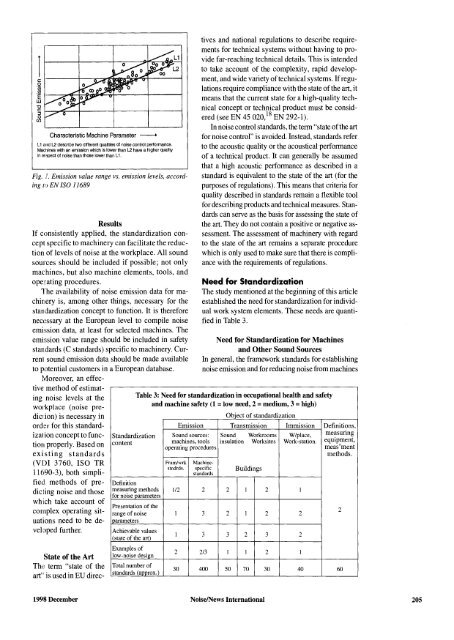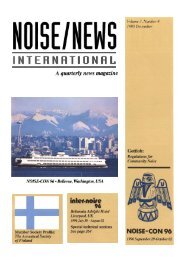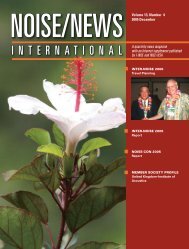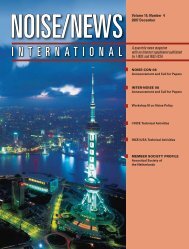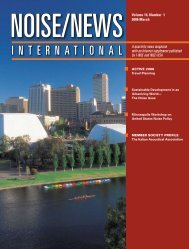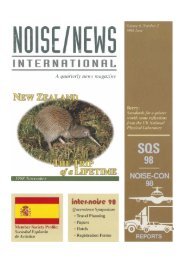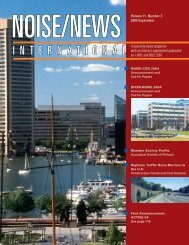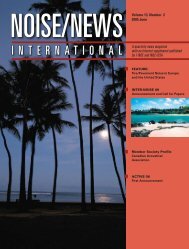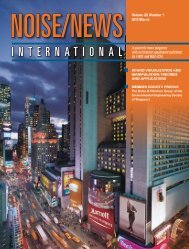Volume 6, Number 4, December, 1998 - Noise News International
Volume 6, Number 4, December, 1998 - Noise News International
Volume 6, Number 4, December, 1998 - Noise News International
Create successful ePaper yourself
Turn your PDF publications into a flip-book with our unique Google optimized e-Paper software.
c:<br />
o<br />
.~<br />
"E f---7""'lf-1I:-i~;J4'.--oi----t-----;<br />
w<br />
-0 c:<br />
::J<br />
OJ<br />
Characteristic Machine Parameter ---4<br />
L1 andl2 describe twodifferent qualities of noisecontrolpertormance.<br />
Mac~lines withan emission whichis lowerthanl2 havea higherquality<br />
in respectof noisethanthoselowerthan L1.<br />
Fig. l. Emission value rangevs. emission levels, according<br />
to EN ISO 11689<br />
Results<br />
If consistently applied, the standardization concept<br />
specific to machinery can facilitate the reduction<br />
of levels of noise at the workplace. All sound<br />
sources should be included if possible; not only<br />
machines, but also machine elements, tools, and<br />
operating procedures.<br />
The availability of noise emission data for machinery<br />
is, among other things, necessary for the<br />
standardization concept to function. It is therefore<br />
necessary at the European level to compile noise<br />
emission data, at least for selected machines. The<br />
emission value range should be included in safety<br />
standards (C standards) specific to machinery. Current<br />
sound emission data should be made available<br />
to potential customers in a European database.<br />
Moreover, an effective<br />
method of estimating<br />
noise levels at the<br />
workplace (noise prediction)<br />
is necessary in<br />
order for this standardization<br />
concept to function<br />
properly. Based on<br />
existing standards<br />
(VDI 3760, ISO TR<br />
11690-3), both simplified<br />
methods of predie<br />
ting noise and those<br />
which take account of<br />
complex operating situations<br />
need to be developed<br />
further.<br />
State of the Art<br />
The term "state of the<br />
art" is used in ED direc-<br />
Table 3: Need for standardization in occupational health and safety<br />
and machine safety (1 =low need, 2 =medium, 3 =high)<br />
Object of standardization<br />
Emission Transmission Immission Definitions,<br />
Standardization Sound sources: Sound Workrooms Wlp1ace, measuring<br />
content machines, tools insulation Worksites Work-station. equipment,<br />
operating procedures<br />
meas'rnent<br />
methods.<br />
Framlwrk Machinestndrds.<br />
specific Buildings<br />
standards<br />
Definition<br />
measuringmethods<br />
for noise parameters<br />
112 2 2 I 2 I<br />
Presentation of the<br />
range of noise 1 3 2 1 2 2<br />
parameters<br />
Achievable values<br />
(state of the art)<br />
Examples of<br />
low-noise design<br />
Total number of<br />
standards (approx.)<br />
tives and national regulations to describe requirements<br />
for technical systems without having to provide<br />
far-reaching technical details. This is intended<br />
to take account of the complexity, rapid development,<br />
and wide variety of technical systems. Ifregulations<br />
require compliance with the state of the art, it<br />
means that the current state for a high-quality technical<br />
concept or technical product must be considered<br />
(see EN 45020,18 EN 292-1).<br />
In noise control standards, the term "state of the art<br />
for noise control" is avoided. Instead, standards refer<br />
to the acoustic quality or the acoustical performance<br />
of a technical product. It can generally be assumed<br />
that a high acoustic performance as described in a<br />
standard is equivalent to the state of the art (for the<br />
purposes of regulations). This means that criteria for<br />
quality described in standards remain a flexible tool<br />
for describing products and technical measures. Standards<br />
can serve as the basis for assessing the state of<br />
the art. They do not contain a positive or negative assessment.<br />
The assessment of machinery with regard<br />
to the state of the art remains a separate procedure<br />
which is only used to make sure that there is compliance<br />
with the requirements of regulations.<br />
Need for Standardization<br />
The study mentioned at the beginning of this article<br />
established the need for standardization for individual<br />
work system elements. These needs are quantified<br />
in Table 3.<br />
Need for Standardization for Machines<br />
and Other Sound Sources<br />
In general, the framework standards for establishing<br />
noise emission and for reducing noise from machines<br />
1 3 3 2 3 2<br />
2 2/3 1 1 2 1<br />
30 400 50 70 30 40 60<br />
2<br />
<strong>1998</strong> <strong>December</strong><br />
<strong>Noise</strong>l<strong>News</strong> <strong>International</strong> 205


